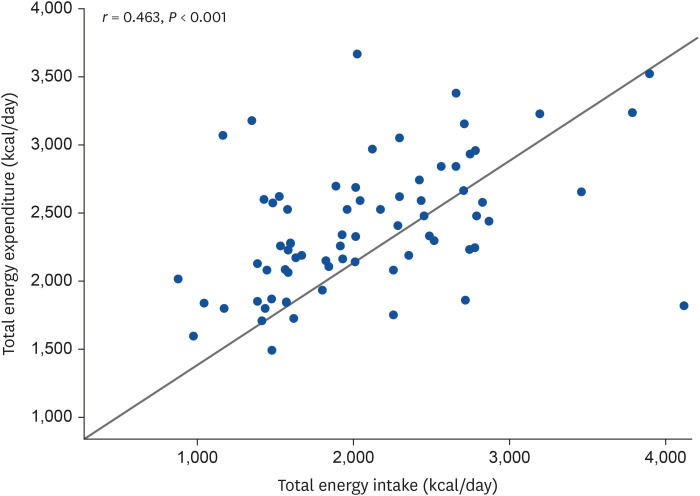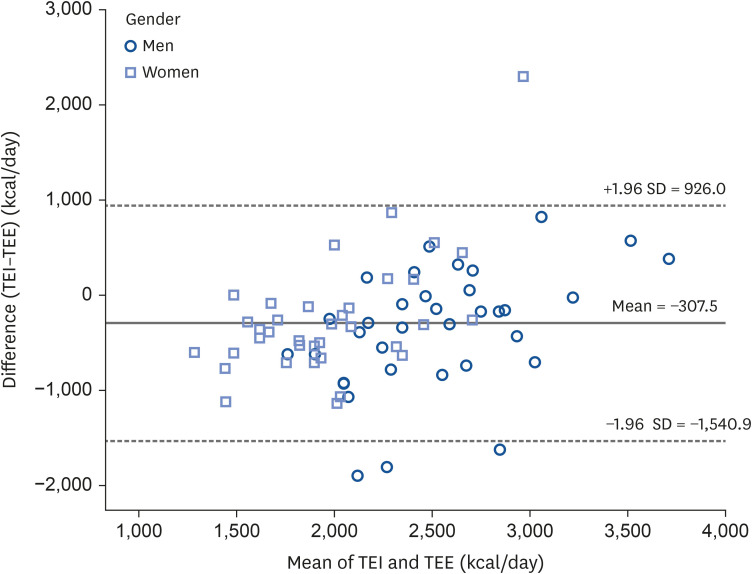1. Ma Y, Hebert J, Ebbeling C, Ockene I. International aspects of coronary heart disease epidemiology. Becker RC, Alpert JS, editors. Cardiovascular Medicine-Practice and Management. London: Arnold;2001. p. 3–20.
2. Liu S. Whole-grain foods, dietary fiber, and type 2 diabetes: searching for a kernel of truth. Am J Clin Nutr. 2003; 77:527–529. PMID:
12600838.

3. American Institute for Cancer Research. Food, Nutrition, Physical Activity and the Prevention of Cancer: A Global Perspective. Washington D.C.: American Institute for Cancer Research;2007.
4. Ma Y, Olendzki BC, Pagoto SL, Hurley TG, Magner RP, Ockene IS, Schneider KL, Merriam PA, Hébert JR. Number of 24-hour diet recalls needed to estimate energy intake. Ann Epidemiol. 2009; 19:553–559. PMID:
19576535.

5. Willett W. The Korean Society of Nutritional Epidemiology. Nutritional Epidemiology (Translated Version). 3th ed. Seoul: Kyomunsa;2013.
6. Ministry of Health and Welfare of Korea, Korea Centers for Disease Control and Prevention. Korea Health Statistics 2016: Korea National Health and Nutrition Examination Survey (KNHANES VII-1). Cheongju: Korea Centers for Disease Control and Prevention;2018.
7. Biró G, Hulshof KF, Ovesen L, Amorim Cruz JA; EFCOSUM Group. Selection of methodology to assess food intake. Eur J Clin Nutr. 2002; 56(Suppl 2):S25–S32.

8. Lafay L, Basdevant A, Charles MA, Vray M, Balkau B, Borys JM, Eschwège E, Romon M. Determinants and nature of dietary underreporting in a free-living population: the Fleurbaix Laventie Ville Santé (FLVS) Study. Int J Obes Relat Metab Disord. 1997; 21:567–573. PMID:
9226487.

9. Goldberg GR, Black AE, Jebb SA, Cole TJ, Murgatroyd PR, Coward WA, Prentice AM. Critical evaluation of energy intake data using fundamental principles of energy physiology: 1. Derivation of cut-off limits to identify under-recording. Eur J Clin Nutr. 1991; 45:569–581. PMID:
1810719.
10. Salvador Castell G, Serra-Majem L, Ribas-Barba L. What and how much do we eat? 24-hour dietary recall method. Nutr Hosp. 2015; 31(Suppl 3):46–48. PMID:
25719770.
11. Livingstone MB, Prentice AM, Coward WA, Strain JJ, Black AE, Davies PS, Stewart CM, McKenna PG, Whitehead RG. Validation of estimates of energy intake by weighed dietary record and diet history in children and adolescents. Am J Clin Nutr. 1992; 56:29–35. PMID:
1609757.

12. Livingstone MB, Prentice AM, Strain JJ, Coward WA, Black AE, Barker ME, McKenna PG, Whitehead RG. Accuracy of weighed dietary records in studies of diet and health. BMJ. 1990; 300:708–712. PMID:
2386561.

13. Westerterp KR, Saris WH, van Es M, ten Hoor F. Use of the doubly labeled water technique in humans during heavy sustained exercise. J Appl Physiol (1985). 1986; 61:2162–2167. PMID:
3027022.

14. Prentice AM, Black AE, Coward WA, Davies HL, Goldberg GR, Murgatroyd PR, Ashford J, Sawyer M, Whitehead RG. High levels of energy expenditure in obese women. Br Med J (Clin Res Ed). 1986; 292:983–987.

15. Lifson N, Gordon GB, McCLINTOCK R. Measurement of total carbon dioxide production by means of D2O18. J Appl Physiol. 1955; 7:704–710. PMID:
14381351.
16. Park J, Kazuko IT, Kim E, Kim J, Yoon J. Estimating free-living human energy expenditure: practical aspects of the doubly labeled water method and its applications. Nutr Res Pract. 2014; 8:241–248. PMID:
24944767.

17. Institute of Medicine of the National Academies (US). Dietary Reference Intakes for Energy, Carbohydrate, Fiber, Fat, Fatty Acids, Cholesterol, Protein, and Amino Acids. Washington, D.C.: National Academies Press;2002.
18. Hill JO, Wyatt HR, Peters JC. Energy balance and obesity. Circulation. 2012; 126:126–132. PMID:
22753534.

19. Johnson RK, Driscoll P, Goran MI. Comparison of multiple-pass 24-hour recall estimates of energy intake with total energy expenditure determined by the doubly labeled water method in young children. J Am Diet Assoc. 1996; 96:1140–1144. PMID:
8906138.

20. Johnson RK, Soultanakis RP, Matthews DE. Literacy and body fatness are associated with underreporting of energy intake in US low-income women using the multiple-pass 24-hour recall: a doubly labeled water study. J Am Diet Assoc. 1998; 98:1136–1140. PMID:
9787719.

21. Bhutani S, Racine N, Shriver T, Schoeller DA. Special considerations for measuring energy expenditure with doubly labeled water under a typical condition. J Obes Weight Loss Ther. 2015; 5:002. PMID:
26962472.
22. Park KW, Go NY, Jeon JH, Ndahimana D, Ishikawa-Takata K, Park J, Kim EK. Accuracy of the 24-hour diet recall method to determine energy intake in elderly women compared with the doubly labeled water method. J Nutr Health. 2020; 53:476–487.

23. Jeon JH, Go NY, Lee MR, Ndahimana D, Kim EK. Accuracy of 24-hour diet recalls for estimating energy intake in elderly men using the doubly labeled water method. Korean J Community Nutr. 2018; 23:516–524.

24. Kim EK, Kim JH, Kim MH, Ndahimana D, Yean SE, Yoon JS, Kim JH, Park J, Ishikawa-Takata K. Validation of dietary reference intake equations for estimating energy requirements in Korean adults by using the doubly labeled water method. Nutr Res Pract. 2017; 11:300–306. PMID:
28765776.

25. Black AE, Prentice AM, Coward WA. Use of food quotients to predict respiratory quotients for the doubly-labelled water method of measuring energy expenditure. Hum Nutr Clin Nutr. 1986; 40:381–391. PMID:
3771290.
26. Weir JB. New methods for calculating metabolic rate with special reference to protein metabolism. J Physiol. 1949; 109:1–9. PMID:
15394301.

27. Barnston AG. Correspondence among the correlation, RMSE, and Heidke forecast verification measures; refinement of the Heidke score. Weather Forecast. 1992; 7:699–709.

28. Weijs PJ. Validity of predictive equations for resting energy expenditure in US and Dutch overweight and obese class I and II adults aged 18-65 y. Am J Clin Nutr. 2008; 88:959–970. PMID:
18842782.

29. Marra M, Montagnese C, Sammarco R, Amato V, Della Valle E, Franzese A, Contaldo F, Pasanisi F. Accuracy of predictive equations for estimating resting energy expenditure in obese adolescents. J Pediatr. 2015; 166:1390–1396.e1. PMID:
25872963.

30. Hill RJ, Davies PS. The validity of self-reported energy intake as determined using the doubly labelled water technique. Br J Nutr. 2001; 85:415–430. PMID:
11348556.

31. Mertz W. Food intake measurements: is there a “gold standard”? J Am Diet Assoc. 1992; 92:1463–1465. PMID:
1452958.

32. Gemming L, Rush E, Maddison R, Doherty A, Gant N, Utter J, Ni Mhurchu C. Wearable cameras can reduce dietary under-reporting: doubly labelled water validation of a camera-assisted 24 h recall. Br J Nutr. 2015; 113:284–291. PMID:
25430667.

33. Subar AF, Kipnis V, Troiano RP, Midthune D, Schoeller DA, Bingham S, Sharbaugh CO, Trabulsi J, Runswick S, Ballard-Barbash R, et al. Using intake biomarkers to evaluate the extent of dietary misreporting in a large sample of adults: the OPEN study. Am J Epidemiol. 2003; 158:1–13. PMID:
12835280.

34. Tran KM, Johnson RK, Soultanakis RP, Matthews DE. In-person vs telephone-administered multiple-pass 24-hour recalls in women: validation with doubly labeled water. J Am Diet Assoc. 2000; 100:777–783. PMID:
10916515.
35. Gemming L, Doherty A, Kelly P, Utter J, Ni Mhurchu C. Feasibility of a SenseCam-assisted 24-h recall to reduce under-reporting of energy intake. Eur J Clin Nutr. 2013; 67:1095–1099. PMID:
24002044.

36. Moshfegh AJ, Rhodes DG, Baer DJ, Murayi T, Clemens JC, Rumpler WV, Paul DR, Sebastian RS, Kuczynski KJ, Ingwersen LA, et al. The US Department of Agriculture Automated Multiple-Pass Method reduces bias in the collection of energy intakes. Am J Clin Nutr. 2008; 88:324–332. PMID:
18689367.

37. Sawaya AL, Tucker K, Tsay R, Willett W, Saltzman E, Dallal GE, Roberts SB. Evaluation of four methods for determining energy intake in young and older women: comparison with doubly labeled water measurements of total energy expenditure. Am J Clin Nutr. 1996; 63:491–499. PMID:
8599311.

38. Riumallo JA, Schoeller D, Barrera G, Gattas V, Uauy R. Energy expenditure in underweight free-living adults: impact of energy supplementation as determined by doubly labeled water and indirect calorimetry. Am J Clin Nutr. 1989; 49:239–246. PMID:
2916443.

39. Lee MS, Woo MK, Kim SA, Oh SI, Kwak CS. Reproducibility of nutrient intake estimated by three-day 24-hour dietary recall of middle-aged subjects for 6 month intervals. Korean J Community Nutr. 2003; 8:603–609.
40. Black AE, Bingham SA, Johansson G, Coward WA. Validation of dietary intakes of protein and energy against 24 hour urinary N and DLW energy expenditure in middle-aged women, retired men and post-obese subjects: comparisons with validation against presumed energy requirements. Eur J Clin Nutr. 1997; 51:405–413. PMID:
9192200.

41. Tomoyasu NJ, Toth MJ, Poehlman ET. Misreporting of total energy intake in older men and women. J Am Geriatr Soc. 1999; 47:710–715. PMID:
10366171.

42. Johnson RK, Goran MI, Poehlman ET. Correlates of over- and underreporting of energy intake in healthy older men and women. Am J Clin Nutr. 1994; 59:1286–1290. PMID:
8198052.

43. Goran MI, Poehlman ET. Total energy expenditure and energy requirements in healthy elderly persons. Metabolism. 1992; 41:744–753. PMID:
1619993.

44. Heywood P, Harvey PW, Marks GC. An evaluation of energy intakes in the 1983 Australian National Dietary Survey of Adults. Eur J Clin Nutr. 1993; 47:604–606. PMID:
8404797.
45. Briefel RR, Sempos CT, McDowell MA, Chien S, Alaimo K. Dietary methods research in the third National Health and Nutrition Examination Survey: underreporting of energy intake. Am J Clin Nutr. 1997; 65:1203S–1209S. PMID:
9094923.

46. Hirvonen T, Männistö S, Roos E, Pietinen P. Increasing prevalence of underreporting does not necessarily distort dietary surveys. Eur J Clin Nutr. 1997; 51:297–301. PMID:
9152679.

47. Macdiarmid J, Blundell J. Assessing dietary intake: who, what and why of under-reporting. Nutr Res Rev. 1998; 11:231–253. PMID:
19094249.

48. Tabacchi G, Amodio E, Di Pasquale M, Bianco A, Jemni M, Mammina C. Validation and reproducibility of dietary assessment methods in adolescents: a systematic literature review. Public Health Nutr. 2014; 17:2700–2714. PMID:
24476625.

49. Lopes TS, Luiz RR, Hoffman DJ, Ferriolli E, Pfrimer K, Moura AS, Sichieri R, Pereira RA. Misreport of energy intake assessed with food records and 24-h recalls compared with total energy expenditure estimated with DLW. Eur J Clin Nutr. 2016; 70:1259–1264. PMID:
27273069.

50. Lichtman SW, Pisarska K, Berman ER, Pestone M, Dowling H, Offenbacher E, Weisel H, Heshka S, Matthews DE, Heymsfield SB. Discrepancy between self-reported and actual caloric intake and exercise in obese subjects. N Engl J Med. 1992; 327:1893–1898. PMID:
1454084.

51. Black AE, Goldberg GR, Jebb SA, Livingstone MB, Cole TJ, Prentice AM. Critical evaluation of energy intake data using fundamental principles of energy physiology: 2. Evaluating the results of published surveys. Eur J Clin Nutr. 1991; 45:583–599. PMID:
1810720.
52. Bathalon GP, Tucker KL, Hays NP, Vinken AG, Greenberg AS, McCrory MA, Roberts SB. Psychological measures of eating behavior and the accuracy of 3 common dietary assessment methods in healthy postmenopausal women. Am J Clin Nutr. 2000; 71:739–745. PMID:
10702167.

53. Bingham SA, Cassidy A, Cole TJ, Welch A, Runswick SA, Black AE, Thurnham D, Bates C, Khaw KT, Key TJ, et al. Validation of weighed records and other methods of dietary assessment using the 24 h urine nitrogen technique and other biological markers. Br J Nutr. 1995; 73:531–550. PMID:
7794870.

54. Hebert JR, Clemow L, Pbert L, Ockene IS, Ockene JK. Social desirability bias in dietary self-report may compromise the validity of dietary intake measures. Int J Epidemiol. 1995; 24:389–398. PMID:
7635601.

55. Nelson M. Editorial-Can we measure what people eat? J Hum Nutr Diet. 1995; 8:1–2.








 PDF
PDF Citation
Citation Print
Print






 XML Download
XML Download